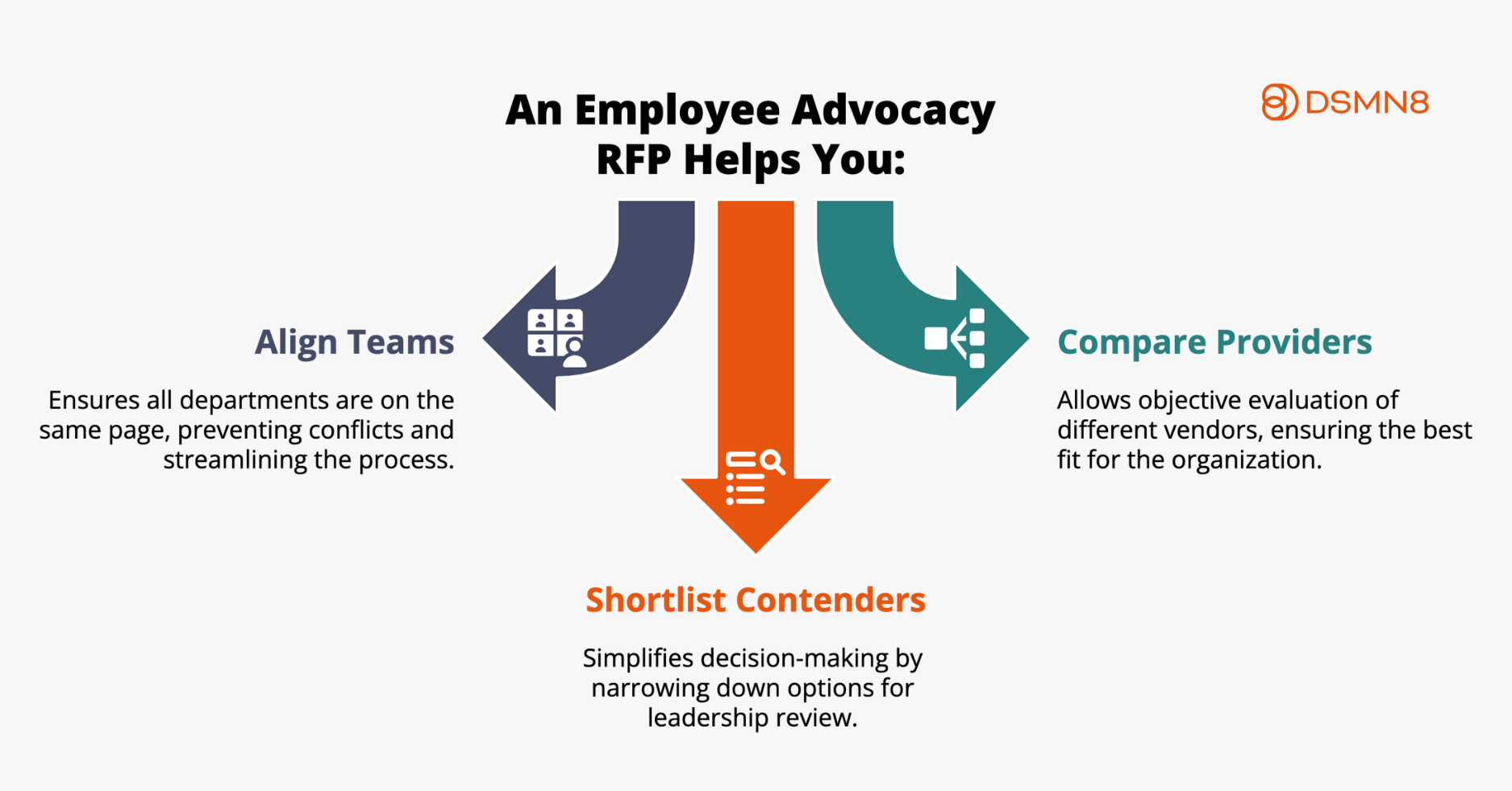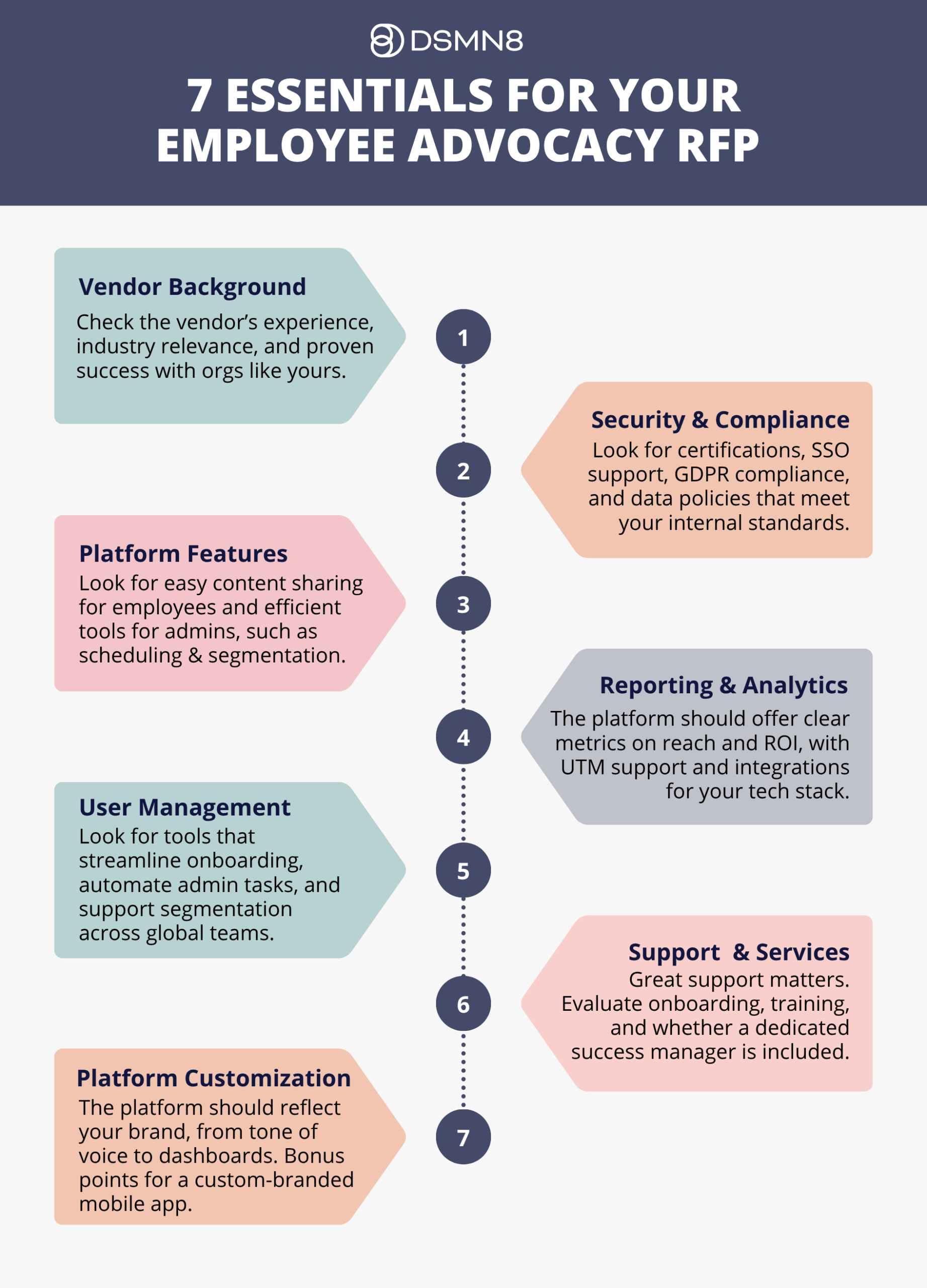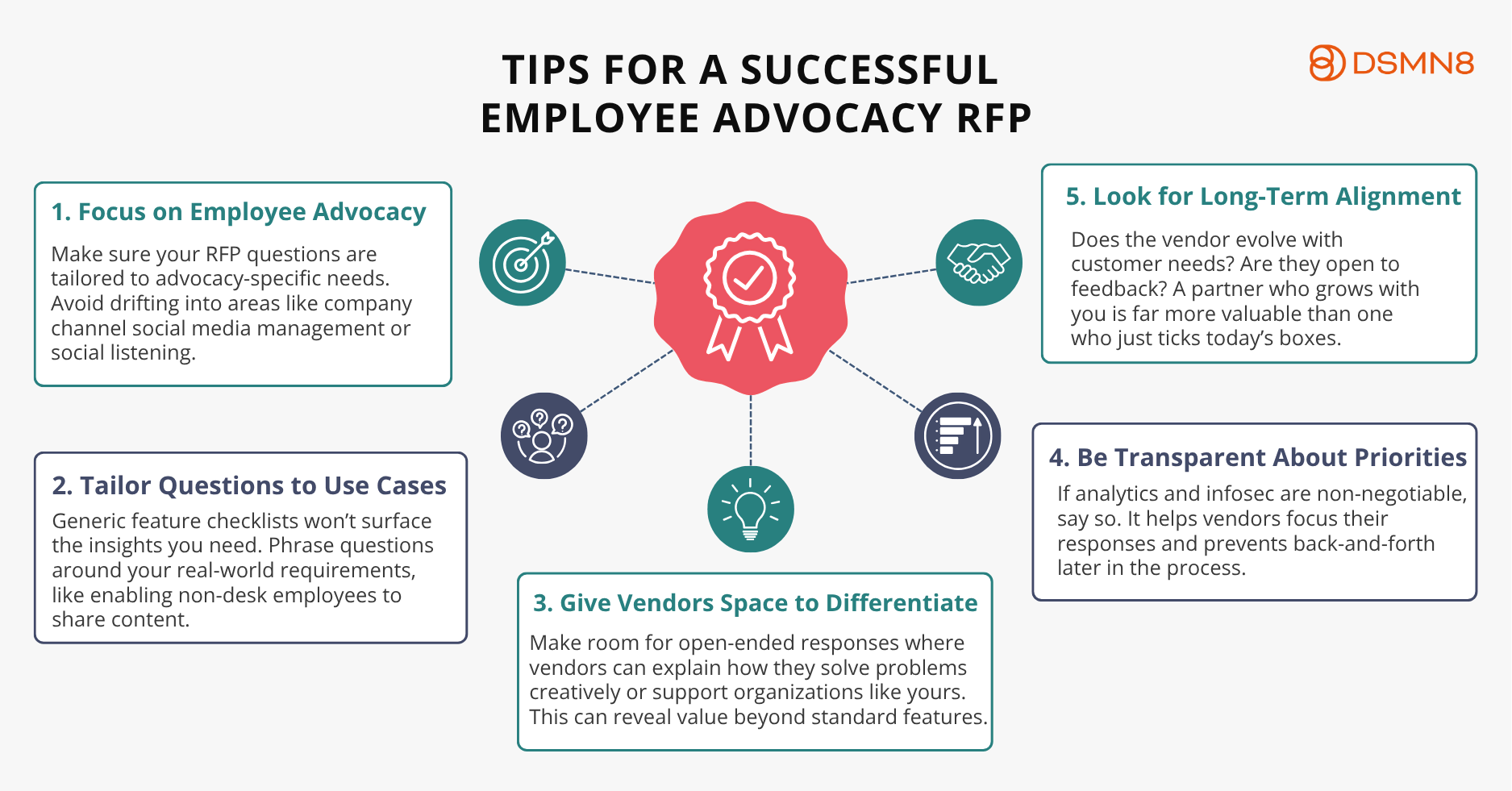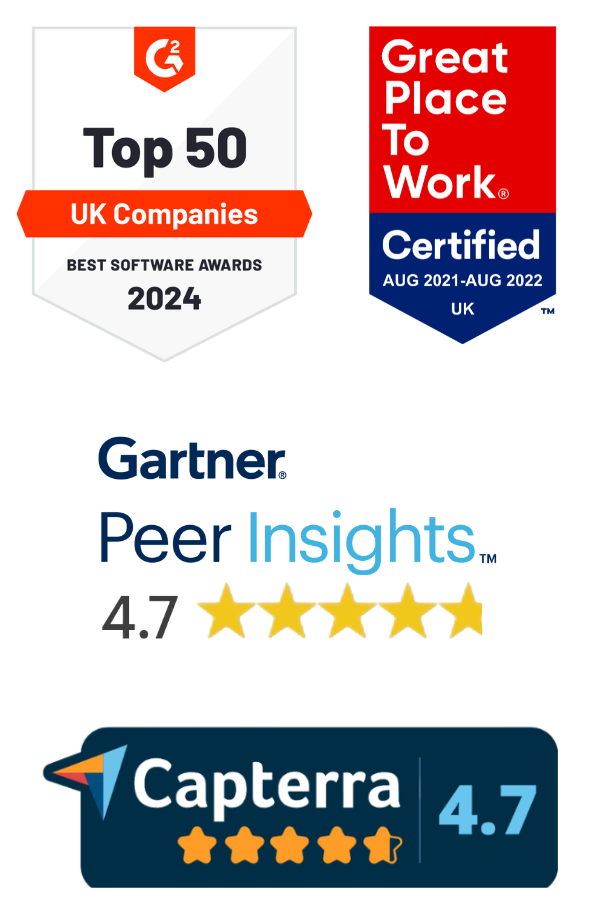
So, you’ve decided it’s time to invest in employee advocacy software. Maybe you’re scaling a manual program, needing better analytics, or you’ve outgrown spreadsheets and Slack threads. Whatever the case, your company might need to run an RFP before investing in company-wide tech.
But where do you start? What are the must-know answers you need from employee advocacy technology vendors?
Here’s everything you need to know to run an RFP for employee advocacy software, with a free template to help you get it done.
What Is an RFP and When Should You Run One?
A Request for Proposal (RFP) is a formal document that invites vendors to pitch their solution for your business challenge. In this case, it’s to help you find the right employee advocacy software.
You might not need one if you’re a small team or piloting with a handful of users. However, for larger organizations or those with strict requirements regarding security, compliance, or procurement, it may be essential.
Running an RFP helps you:
- Align multiple teams and priorities (Marketing, IT, HR, Legal, Procurement).
- Compare providers objectively, from the technology to support.
- Shortlist the top contenders and make your decision-making clear to leadership.
Internal Preparation Before Launching an RFP
Before reaching out to vendors, it’s essential to clarify a few key points.
1. What’s your primary goal with an employee advocacy platform?
Are you seeking detailed analytics to demonstrate ROI? AI tools to streamline content creation? Advanced user segmentation?
Clear goals will help you evaluate which platform best supports your needs and which features are genuinely essential. Separate the nice-to-haves from the must-haves. For example, if your employee advocates are largely not desk-based, a mobile app would be a priority.
2. Who’s involved?
Create a list of internal stakeholders early, especially those from Legal, IT/Security, and your program lead. If your company has specific security requirements from external software providers, it’s important to be aware of these in advance.
3. What does success look like?
Think beyond initial launch. What does a successful rollout and long-term adoption look like for your organization?
- Is success high engagement from a specific department (e.g., sales or senior leadership)?
- Do you need a solution to scale globally with localized content in multiple languages?
- Are you aiming to track specific metrics, like content reach, engagement, or earned media value?
When you’re clear on what success looks like, it’s easier for vendors to show how they’ll actually help you get there, from onboarding to strategy to long-term support.
What to Include in Your Employee Advocacy Software RFP
Your RFP doesn’t need to be 20 pages long (unless required by your legal team!). In fact, the best ones are simple and structured, making it easy to compare solutions.
We recommend using a spreadsheet to evaluate vendors side by side. To make things even easier, we’ve created a ready-to-use Google Sheets template you can copy and customize.
Below, we’ve outlined the key areas your RFP should cover. Each section is designed to help you assess not just platform features, but fit, scalability, and long-term success.
Get the template for the full list of questions, along with a built-in scoring system that includes average scores by category, a total average score, and bar chart visualizations to help you evaluate vendors clearly and confidently.
1. Vendor Background
Choosing the right partner starts with understanding their background. Consider the vendor’s experience, track record in your industry, and ability to provide case studies that show proven success with organizations like yours.
2. Security & Compliance
Data protection is non-negotiable, especially when employee and company information is involved. Look for vendors with recognized certifications such as ISO27001 or SOC 2, robust SSO options, GDPR compliance, and clear data handling policies that align with your internal security standards.
3. Platform Features & Functionality
The right platform should serve both the people using it and the teams managing it. From an intuitive employee experience to powerful admin tools, you’ll need to evaluate how well a solution supports daily engagement and long-term scalability.
Users
A seamless user experience drives adoption and long-term engagement.
Focus on how employees discover and share content, how intuitive the platform feels, the quality of the mobile experience, and whether it offers personalization that makes daily use more relevant and rewarding.
Admins
Admin capabilities play a major role in how efficiently your program runs and how much time program managers will need to dedicate.
Consider how easily you can schedule content, segment users by role or region, customize the platform to fit your structure, and scale operations as your team or program grows. You’ll also want to consider how well the platform integrates with your existing tech stack, from internal comms platforms like Slack and Teams to Google Analytics and other reporting tools.
If your leadership team is seeking a hands-off approach to building their LinkedIn presence, look for delegate access features that enable admins to manage their accounts without sharing passwords.
4. Reporting & Analytics
Insightful reporting is key to measuring employee advocacy ROI and proving program impact to leadership. Look for analytics that track content reach and user adoption, with support for UTM parameters and earned media value.
The ability to export data and integrate with tools like GA4 or your CRM makes it easier to share results and refine your strategy.
5. User Management
Strong user management ensures your program can scale with ease. Look for features that simplify onboarding and offboarding, provide clear permission controls, and support user segmentation by region, department, or role.
This is especially important for global teams because manual processes can quickly become time-consuming and error-prone. Automation ensures consistency at scale, while strong oversight helps maintain control, compliance, and a positive user experience across different regions and departments.
6. Support & Services
Remember that great software is only part of the equation. Quality of support and vendor expertise contributes to long-term success. The best software in the world won’t help if it’s hard to implement or you’re left figuring things out on your own!
Consider how the vendor approaches onboarding, the training resources they offer, whether a dedicated success manager is included, and how actively they help you achieve your goals.
7. Platform Customization
Flexibility is key to making a platform feel like a natural extension of your brand.
Look for customization options that allow you to control branding, adjust tone of voice, tailor user experiences, and build analytics dashboards that align with your goals. A custom-branded mobile app can help boost recognition and engagement among employees, especially those who are non-desk-based.
RFP Template for Employee Advocacy Software
Need a head start? We’ve created a ready-to-use employee advocacy platform RFP template in Google Sheets.
It’s fully editable, includes structured questions, space to compare vendors side by side, and built-in scoring logic to help you make confident, informed decisions. With visual summaries and space for adding notes, this will support internal discussions and procurement workflows.
Tips for a Successful RFP Process
1. Focus on employee advocacy.
Make sure your RFP questions are tailored to advocacy-specific needs. Avoid drifting into areas like company channel social media management or social listening, which fall outside the core purpose of these platforms.
2. Tailor questions to your use cases.
Generic feature checklists won’t surface the insights you need. Phrase questions around your real-world requirements, like enabling non-desk employees to share content.
3. Give vendors space to differentiate.
Make room for open-ended responses where vendors can explain how they solve problems creatively or support organizations like yours. This can reveal value beyond standard features.
4. Be transparent about your priorities.
If analytics and infosec are non-negotiable, say so. It helps vendors focus their responses and prevents back-and-forth later in the process.
5. Look for long-term alignment, not just feature fit.
Does the vendor evolve with customer needs? Are they open to feedback? A partner who grows with you is far more valuable than one who just ticks today’s boxes.
🎧 Struggling to get cross-functional support for advocacy?
Procore’s Melissa Heidmiller shares practical tips on tailoring ROI conversations and effectively getting internal buy-in for your program.
Next Steps
Once you’ve reviewed written responses, invite your shortlist for a tailored demo. Ask to see your use cases in action, not just a generic product walkthrough.
Things to look out for:
- How easy is the platform to use for non-tech teams?
- Do their analytics show the metrics you need?
- Can the vendor show real success stories, not just theory?
Final Thoughts & Additional Resources
The best employee advocacy platform isn’t just the one with the longest feature list. It’s the one your people will actually use.
Pick a partner that understands your goals, supports your team, and helps you grow.
Ready to see how DSMN8 stacks up? Book your demo today.
More resources you’ll find helpful:
Emily Neal
SEO and Content Specialist at DSMN8. Emily has 10 years experience blogging, and is a pro at Pinterest Marketing, reaching 1 million monthly views. She’s all about empowering employees to grow their personal brands and become influencers.






